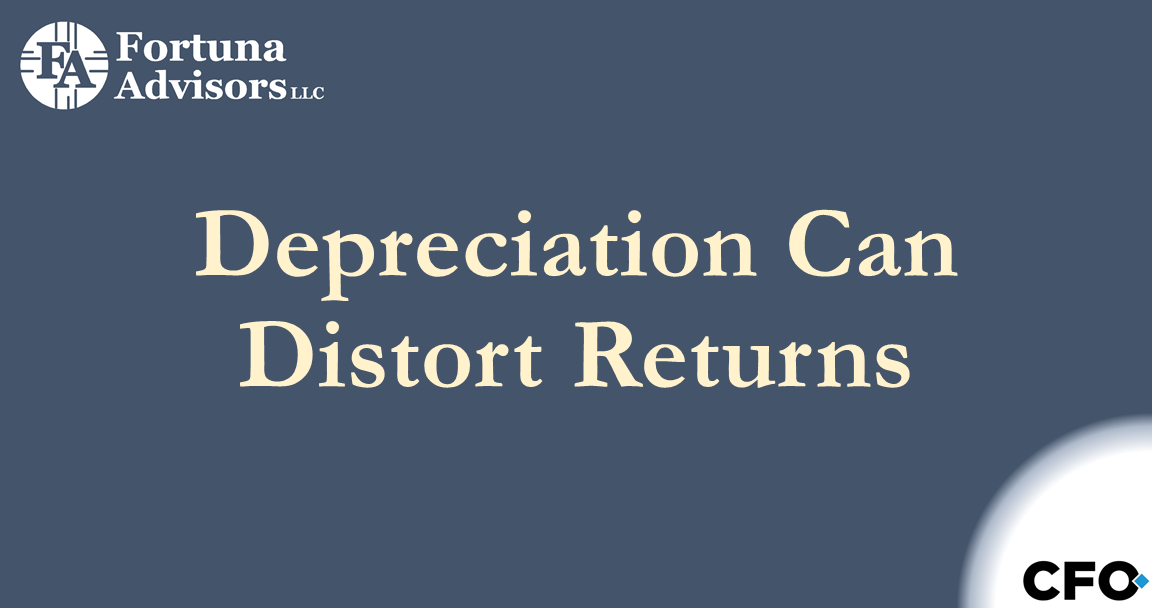Over the years, more and more companies have turned their attention to measures of rates of return and/or economic profit to figure out how effectively management is using shareholder capital. These can provide a more complete indication of success than profit, cash flow, and margin metrics that ignore capital utilization.
But unfortunately, the nature of depreciation often distorts return and economic profit measures and can convey an undesirable strategic bias against investing in future growth.
It is easy to see the benefit of adopting measures such as return on invested capital, return on net assets (RONA), economic profit (EP), and economic value added. These measures compare some measure of profit or cash flow to the amount of capital or assets utilized to produce the profit or cash flow.
As such, these measures help management make choices and prioritize future investments. Managements embracing these measures tend to be more disciplined in their capital investment and more resourceful in disposing of unneeded assets, and have a propensity to run businesses that are more capital efficient, which shareholders tend to be thankful for.
 But these measures often unintentionally encourage undesirable behaviors that executives must be careful to avoid. Because of the nature of depreciation, these measures are often inherently biased against growth investments by making old depreciated assets appear less costly than new assets.
But these measures often unintentionally encourage undesirable behaviors that executives must be careful to avoid. Because of the nature of depreciation, these measures are often inherently biased against growth investments by making old depreciated assets appear less costly than new assets.
To understand this, consider that the majority of return and economic profit measures are based on GAAP accounting, often with some adjustments, but typically with depreciation treated as a period cost against income and with an asset base that is net of accumulated depreciation.
As shown in the chart below, given the cash-flow profile of a typical depreciating asset, the return measures start low and improve over time as the denominator depreciates. The economic profit measures are similar in that new assets appear to have a higher cost of ownership (depreciation plus the capital charge) and this discourages new investments in favor of old assets.
 This simplified example reflects an investment of $1000 (Line 5) at the end of 2012 in an asset with a fiveyear, straight-line depreciation life (Line 2). Note that the net property, plant, and equipment (PP&E) declines by the depreciation each year. The hypothetical EBITDA (Line 1) and 40% income-tax assumption (Line 3) fill out the rest of the inputs.
This simplified example reflects an investment of $1000 (Line 5) at the end of 2012 in an asset with a fiveyear, straight-line depreciation life (Line 2). Note that the net property, plant, and equipment (PP&E) declines by the depreciation each year. The hypothetical EBITDA (Line 1) and 40% income-tax assumption (Line 3) fill out the rest of the inputs.
The required return, often considered the same as the cost of capital, is 10% (Line 11) and the internal rate of return (IRR) of the investment is 11% (Line 10), which is 1% above the required return. The IRR is the annualized compounded return rate of the free cash flows from a particular investment, and standard corporate finance theory and practice suggests that when the IRR is above the required return, the investment adds value and should be accepted. Therefore, the investment in this example should be made.
But notice in 2013 and 2014, the RONA is below the required return and the EP is negative. Despite the decision that might be reached based on the IRR analysis, many executives who are measured based on RONA or EP year by year and even quarter by quarter would be hesitant to make the investment. In fact, if business-unit management is evaluated on a RONA basis, this investment might not even be proposed to senior decision makers.
A glance to the later years of the example makes it clear why management teams often prefer to stick with old depreciated assets than invest in new ones. As the assets depreciate away, the RONA and EP tend to rise. This can drive management to reinvest less than they should, which can inhibit growth, and in some cases, can lead to a competitive disadvantage where peers invest more in new differentiated technology and can do a better job of attracting clients at better prices.
Some rightly say that EBITDA often doesn’t rise over the depreciation life of an asset the way it is depicted in this example. Often there are maintenance costs and investments, increased downtime, and pricing-power erosion to contend with. But it would take 36% higher EBITDA in Year 1 and 13% average annual erosion in EBITDA for the IRR to still be 11% and the RONA to be constant each year in the face of the declining assets. Very rarely do assets show such peak returns in Year 1 and such sharp declines every year thereafter: in fact, new investments often suffer additional delays during start-up periods that reduce initial EBITDA.
The message to CFOs is clear: while it is desirable to use rates of return and economic profit– like measures, the metrics should be defined in such a way that depreciation conventions don’t create a bias toward underinvesting in the business. To ensure the right balance of growth and return, CFOs need to pay more than lip service to long-term discounted cash-flow IRR. They should replace return on capital and economic profit with measures less biased against growth, which can often be done by not charging depreciation against income and utilizing gross undepreciated assets rather than net assets.
It can also help to create a culture of explicitly developing strategies, making decisions, and assessing performance inside the company to boost efficiency, growth, and sustainability over time.

